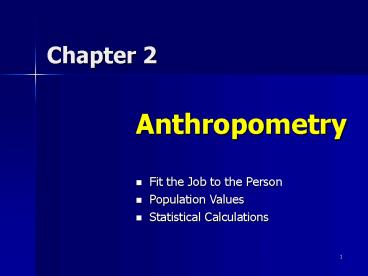Anthropometry - PowerPoint PPT Presentation
1 / 26
Title:
Anthropometry
Description:
Body Dimensions. Sample 95th percentile dimensions (cm) of nude U.S. ... body dimensions ... volume there is an optimum shape. Volume increases by the third ... – PowerPoint PPT presentation
Number of Views:326
Avg rating:3.0/5.0
Title: Anthropometry
1
Chapter 2
- Anthropometry
- Fit the Job to the Person
- Population Values
- Statistical Calculations
2
Anthropometry
Anthropos (man) metrein (to measure)The study
of how people vary in
- Visual acuity
- Determination
- Upper back strength
- Age
- Leg length
- And so forth . . . .
- Initiative
- Imagination
- Needs
- Dexterity
- Intelligence
3
Selection vs. Job Modification
- Two basic strategies
- Selectionfit the person to the job.
- Job modificationfit the job to the person
- Follow the second the key to progress has been
to challenge the environment.
4
Exclude as Few as Possible
- Minimizes the number of people excluded
- Tends to make the job easier for everyone
- Balance seriousness of exclusion with cost of
inclusion
5
Excluded Percentile
- May be
- Upper (a door tall people cant fit under)
- Lower (a task requiring manual dexterity)
- Both (intelligence test for factory job)
- Designing for the mean may exclude half the
population.
6
Population Dimensions
- Define the user population.
- Consider the source of population dimensions
- Male/female
- Military/civilian
- Age
- Ethnicity
- Occupation
7
Body Position Descriptions
- Planes
- Saggital (medial/lateral)
- Coronal (anterior/posterior)
- Transverse (superior/inferior)
- Limbs
- Proximal
- Distal
8
Wrist/Hand Motions
- Flexion/extension
9
Wrist/Hand Motions
- Radial deviation/ulnar deviation
10
Wrist/Hand Motions
- Pronation/supination
11
Body Dimensions
- Sample 95th percentile dimensions (cm) of nude
U.S. adult civilians
12
Variations in Stature
- Depend largely on length of legs
- Do not predict other body dimensions
- Do not correspond to other measures (e.g.,
intelligence, dexterity) - Female may be estimated as 93 of male if no data
available
13
Principle of Similitude (see Box 2.8 2.9)
- For every volume there is an optimum shape.
- Volume increases by the third power
- Area increases by the square
- A sphere minimizes surface area for a given volume
14
Principle of Similitude
- Applications
- Big people have a longer moment arm, as well as
larger muscles. - Spheres and cylinders are used for liquid and gas
storage. - Military bunkers and igloos are domes.
- Cartons and boxes are cubes.
- Industrial buildings are rectangular boxes.
- Round ducts have less friction and heat transfer.
15
Variations in Strength
- Females average 63 isometric strength of males.
- Strength of specific muscle groups varies
depending on - Limb Leg approx. 3 times strength of arm
- Direction exerted Strength may decrease by 50
- Preferred hand/arm/leg Strength may vary by
4050 - Left and right leg strengths do not differ
appreciably
16
Other Characteristics
- Weight and center of mass
- Manual dexterity
- Surface area
- Age
- Personal space
- Aisles/corridors/doors
17
Body Dimensions
18
Personal Space
- Intimate (0 18 in.)
- Personal (18 48 in.)
- Social (4 12 ft)
- Public (gt 12 ft)
- Boundaries vary with gender, familiarity, and
culture. - Territoriality refers to long-term occupancy of
space.
19
Aisles
- One-way traffic, people only 3 ft min
- Door opening into aisle 6 ft min
- Doors opening on both sides 8 ft min
- Aisles for people only need not be straight.
- Corridors (aisles with walls) must be wider.
20
Age of Workforce
- Birth rate is declining.
- Additional workers must come from
- Immigration
- Longer work hours
- Delayed retirement
- Older workers must be considered.
21
Statistical Calculations
- Normal distribution provides a close
approximation. - Mean (average) is 50th percentile.
- Normal distribution is symmetrical.
- Absolute variability given by standard deviation.
- Relative variability given by coefficient of
variation.
22
Normal Distribution
23
Distribution Calculations
- To Find Percentile
- Find difference from the mean (subtract).
- Convert to standard units (divide by standard
deviation). - Use table to find percentile.
24
Distribution Calculations
- To Find Dimension
- Use table to find number of standard units from
mean. - Convert to dimension measure (multiply by
standard deviation). - Add or subtract mean.
25
Design for Population or Person?
- If for population, what population?
- Current employees?
- Potential employees?
- Everyone in the world?
- If for person, how?
- Adjustability?
- Discrete sizes?
26
How Many Sizes?
- How much does the population vary?
- How well can a specific size fit part of the
population? - How many dimensions are relevant?
- Sizes and adjustability interact.

